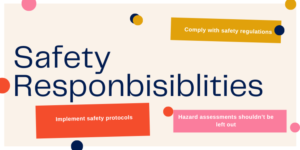Implementing safety procedures in the workplace is crucial for protecting employees from accidents and ensuring a secure working environment. Here’s a comprehensive guide covering various aspects of safety procedures:
- Risk Assessment: Begin by identifying potential hazards in the workplace. Conduct thorough inspections to pinpoint any risks related to machinery, equipment, materials, or processes.
- Safety Training: Provide comprehensive training to employees on safety protocols and procedures. This includes training on how to use equipment safely, emergency procedures, and how to identify and report hazards.
- Emergency Preparedness: Develop and communicate emergency procedures such as evacuation routes, assembly points, and protocols for handling emergencies like fires, chemical spills, or medical emergencies.
- Personal Protective Equipment (PPE): Ensure that appropriate PPE is provided to employees based on the hazards present in the workplace. This may include safety glasses, gloves, helmets, earplugs, or respirators.
- Safety Signage: Install clear and visible signage to indicate hazardous areas, emergency exits, fire extinguishers, first aid stations, and other safety-related information.
- Regular Inspections: Schedule regular inspections of the workplace to identify any new hazards or areas for improvement. Encourage employees to report hazards promptly.
- Safety Committees: Establish safety committees comprising representatives from different departments to regularly review and improve safety procedures. Encourage employee involvement in identifying and addressing safety concerns.
- Safe Work Practices: Develop and enforce safe work practices for all tasks and operations. This may include proper lifting techniques, machinery operation procedures, and guidelines for handling hazardous materials.
- Hazard Communication: Implement a system for communicating hazards to employees, such as labeling hazardous materials, providing safety data sheets (SDS), and conducting training on chemical safety.
- Incident Reporting and Investigation: Establish procedures for reporting and investigating accidents, near misses, and other safety incidents. Use these investigations to identify root causes and implement corrective actions to prevent recurrence.
- Regular Maintenance: Ensure that machinery, equipment, and infrastructure are regularly inspected and maintained to prevent malfunctions or breakdowns that could pose safety risks.
- Continuous Improvement: Regularly review and update safety procedures based on feedback from employees, changes in regulations, or advancements in safety technology.
By implementing these safety procedures and fostering a culture of safety within the workplace, you can reduce the risk of accidents and injuries, protect your employees, and create a safer and more productive work environment.




